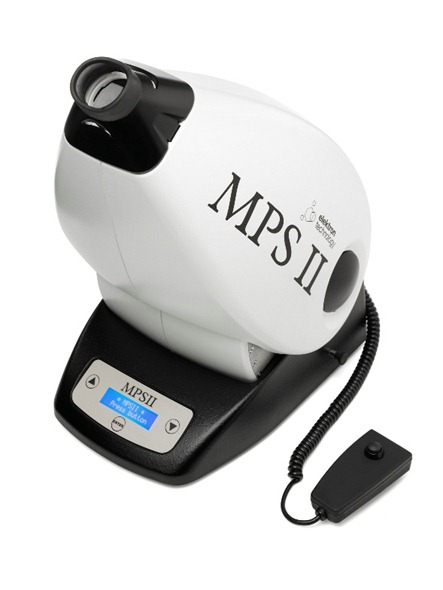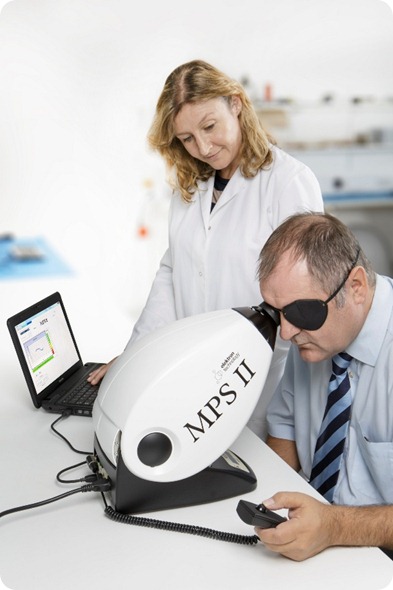Nov 28 2012
Elektron Technology is launching a new, easy-to-use macular pigment screener (MPS II) that can quickly identify those most at risk of developing age-related macular degeneration (AMD).

Clinical data collected from 1.5 million patients is used to support its unique ‘centre only’ screening mode that overcomes the difficulty inherent in other approaches.
AMD is the loss of vision in the centre of the eye and is caused by high-energy, blue light from the sun damaging the retinal protective shield, or macula, over time. The MPS II measures the density of the yellow pigment within the macula that has an important role in absorbing the blue light.
Jaquie Finn, Product Line Manager at Elektron Technology, explains that data amassed over the last five years has been used to develop the fastest and most accurate macular pigment screening test on the market.
“Traditionally, macular pigment screening uses heterochromatic flicker photometry (HFP) to compare the thickness of the pigment in the macula with a peripheral measurement where there is no pigment. This latter test can be difficult for the patient to perform and can result in unreliable data.
“The new MPS II has been developed with the benefit of clinical data previously collected with a first-generation screener. This has allowed us to remove the peripheral measurement and use the patient’s age instead as an estimate of the eye’s response. An accurate result can now be achieved just with a central test.
“Trials of MPS II have shown that it offers a quick, consistent and repeatable screening tool that can identify those with a low macular pigment density and therefore at risk of developing AMD.”

The macula is the small area at the centre of the retina responsible for central vision. Its role is to filter out harmful blue light before it hits the sensitive rods and cones on the retina. As a person gets older the risk of AMD increases, particularly when coupled with poor diet, smoking and drinking. This can accelerate the onset of the disease.
The benefits of screening for risk of AMD will become more widely understood by the public later in 2013. This is when the Age-Related Eye Disease Study 2 (AREDS2) is expected to report that nutritional supplements containing Omega3 and lutein and zeaxanthin – the two pigments that give the macula its colour – can enhance the eye’s protective shield and thus protect against AMD.
Dr Scott Mackie is a consultant optometrist and is a CPD examiner. He is one of the first optometrists to pilot the MPS II. He comments that the MPS II is a very useful tool and that its simplicity of operation is a major benefit.
“The patient looks into the MPS II and when they see the blue light flashing they press a button. It is simple, unambiguous and provides a very accurate test.
“The test is scientifically verified against a substantial amount of data. The results are produced as a graph which you can see being printed in real time and this gives considerable confidence in the accuracy of result.”
“There are a number of risk factors for AMD, such as being over 50, smoking, poor diet, family history of AMD, and fluffy yellow patches called drusen around the macula. If a patient has one or more of these risk factors I would recommend screening using the MPS II.
The new MPS II features innovative software that benefits from over 1.5 million data points acquired by an early instrument called MPOD, which was one of the first devices to measure macular pigment. However, the process is considerably improved, making the instrument much easier to use and more accurate.
Jaquie Finn explains that Elektron Technology is creating a consumer campaign that will launch in 2013, highlighting the benefits of screening and preventative care.
“Consumers in the Far East, particularly Japan and Taiwan, are well aware of the dangers of blue light from computer screens and handheld devices, and sales of ‘yellow tinted’ fashion glasses are very high.
“There is less awareness in the West but we expect that this will change with the results of AREDS2. With the launch of MPS II we are supporting the ophthalmic and optometric channel to get in position to be able to detect and advise those most at risk.”
More details about MPSII are available from Jaquie Finn at Elektron Technology www.elektron-healthcare.com.
About AMD
AMD damages the macula, and as the disease progresses it blurs the patient's central vision, meaning that the sufferer can no longer see people’s faces. The most common form is dry AMD where the light-sensitive cells in the macula slowly break down. Untreated dry AMD can progress into wet AMD, which is caused by the abnormal growth of blood vessels under the macula, leading to rapid loss of central vision.
The first AREDS report showed that high-dose antioxidant vitamins and minerals taken orally reduced the risk of progression to advanced AMD by 25 per cent, and the risk of moderate vision loss by 19 per cent. The second report focuses on the benefits of supplementing with lutein and zeaxanthin and is expected provide clinical evidence of its efficacy.
There is no cure for AMD, which is a major cause of sight loss, but delaying the onset of AMD is now thought to be possible with a combination of diet, lifestyle and nutritional supplements. When the results for AREDS2 are announced in Q2 2013 it is anticipated that GPs and opticians will see a surge in requests for AMD screening.
A new portable screening device for Age-related Macular Degeneration (AMD) - The Macular Pigment Screener (MPS II)
A new portable screening device for Age-related Macular Degeneration (AMD) - The Macular Pigment Screener (MPS II) from Elektron Technology on Vimeo
About Elektron Technology
Cambridge-based Elektron Technology develops and brings to market innovative products in the fields of precision instrumentation, monitoring and control, and connectivity.
Its healthcare division acquired Tinsley Ophthalmics in 2010 and has re-engineered two of its leading-edge products – Henson (visual field perimeter) and MPOD (macular pigment screener) – to improve their accuracy and ease of use.
Electron Technology’s newest product, the Macular Pigment Screener (MPS II), is a new generation instrument for AMD screening. It benefits from a significant investment in software development verified by a wealth of data collated by the MPOD.